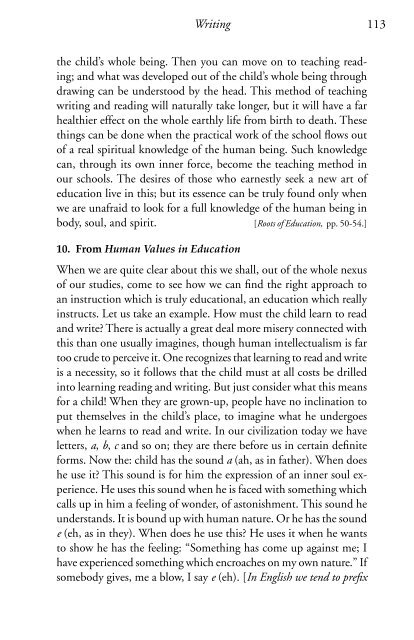Teaching Language arTs in The WaLdorf schooL
Teaching Language arTs in The WaLdorf schooL
Teaching Language arTs in The WaLdorf schooL
Create successful ePaper yourself
Turn your PDF publications into a flip-book with our unique Google optimized e-Paper software.
Writ<strong>in</strong>g<br />
113<br />
the child’s whole be<strong>in</strong>g. <strong>The</strong>n you can move on to teach<strong>in</strong>g read<strong>in</strong>g;<br />
and what was developed out of the child’s whole be<strong>in</strong>g through<br />
draw<strong>in</strong>g can be understood by the head. This method of teach<strong>in</strong>g<br />
writ<strong>in</strong>g and read<strong>in</strong>g will naturally take longer, but it will have a far<br />
healthier effect on the whole earthly life from birth to death. <strong>The</strong>se<br />
th<strong>in</strong>gs can be done when the practical work of the school flows out<br />
of a real spiritual knowledge of the human be<strong>in</strong>g. Such knowledge<br />
can, through its own <strong>in</strong>ner force, become the teach<strong>in</strong>g method <strong>in</strong><br />
our schools. <strong>The</strong> desires of those who earnestly seek a new art of<br />
education live <strong>in</strong> this; but its essence can be truly found only when<br />
we are unafraid to look for a full knowledge of the human be<strong>in</strong>g <strong>in</strong><br />
body, soul, and spirit. [Roots of Education, pp. 50-54.]<br />
10. From Human Values <strong>in</strong> Education<br />
When we are quite clear about this we shall, out of the whole nexus<br />
of our studies, come to see how we can f<strong>in</strong>d the right approach to<br />
an <strong>in</strong>struction which is truly educational, an education which really<br />
<strong>in</strong>structs. Let us take an example. How must the child learn to read<br />
and write? <strong>The</strong>re is actually a great deal more misery connected with<br />
this than one usually imag<strong>in</strong>es, though human <strong>in</strong>tellectualism is far<br />
too crude to perceive it. One recognizes that learn<strong>in</strong>g to read and write<br />
is a necessity, so it follows that the child must at all costs be drilled<br />
<strong>in</strong>to learn<strong>in</strong>g read<strong>in</strong>g and writ<strong>in</strong>g. But just consider what this means<br />
for a child! When they are grown-up, people have no <strong>in</strong>cl<strong>in</strong>ation to<br />
put themselves <strong>in</strong> the child’s place, to imag<strong>in</strong>e what he undergoes<br />
when he learns to read and write. In our civilization today we have<br />
letters, a, b, c and so on; they are there before us <strong>in</strong> certa<strong>in</strong> def<strong>in</strong>ite<br />
forms. Now the: child has the sound a (ah, as <strong>in</strong> father). When does<br />
he use it? This sound is for him the expression of an <strong>in</strong>ner soul experience.<br />
He uses this sound when he is faced with someth<strong>in</strong>g which<br />
calls up <strong>in</strong> him a feel<strong>in</strong>g of wonder, of astonishment. This sound he<br />
understands. It is bound up with human nature. Or he has the sound<br />
e (eh, as <strong>in</strong> they). When does he use this? He uses it when he wants<br />
to show he has the feel<strong>in</strong>g: “Someth<strong>in</strong>g has come up aga<strong>in</strong>st me; I<br />
have experienced someth<strong>in</strong>g which encroaches on my own nature.” If<br />
somebody gives, me a blow, I say e (eh). [In English we tend to prefix

















